![]()
![]()
![]()
Use LEFT and RIGHT arrow keys to navigate between flashcards;
Use UP and DOWN arrow keys to flip the card;
H to show hint;
A reads text to speech;
48 Cards in this Set
- Front
- Back
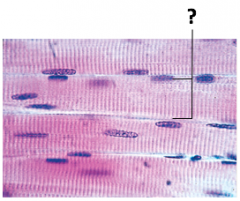
|
Myofibers: Muscle cells containing various organelles and contractile proteins that are used for contraction |
|
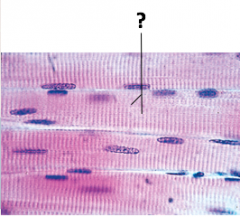
|
Striations: Alternating light and dark bands caused by the overlap of the motor proteins myosin and actin (thick and thin filaments) |
|
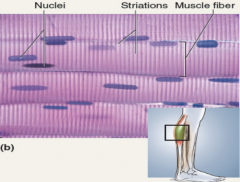
|
Skeletal Muscle: Appearance: long striated (striped) fibers with multiple nuclei; striations caused by the overlap of thick and thin filaments Functions: body movements, facial expression, posture, breathing, speech, swallowing,; VOLUNTARY Locations: skeletal muscle, tongue, encircling the lips, eyelids, urethra, and anus |
|
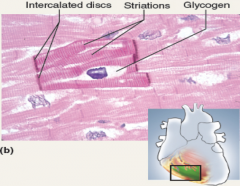
|
Cardiac Muscle: Appearance: short myocytes (muscle cells) with slightly beached ends; striations caused by the overlap of thick and thin filaments; intercalated discs (a complex of adherens, gap junctions, and desmosomes that join cardiac cells; uninucleated Functions: pumping of blood; INVOLUNTARY Location: heart |
|

|
Smooth Muscle: Appearance: short fusiform (tapered at ends) cells overlapping each other; non-striated; uninucleated Functions: swallowing; contractions of gastrointestinal tract; expulsion of urine/feces; labor contractions; blood pressure; pupil diameter; erection of hairs; INVOLUNTARY Locations: sheets of tissue in walls of blood vessels and viscera; Iris; associated with hair follicles; involuntary sphincters of urethra and anus |
|
|
Agonist |
Also called prime mover; the muscle that produces most of the force during a particular joint action |
|
|
Antagonist |
A muscle that opposes the prime mover (agonist); maintains some tension on a joint and thus limits the speed of range of the prime mover |
|
|
Fixator |
A muscle that prevents a bone from moving, allowing other muscles attached to pull on a different bone |
|
|
Synergist |
A muscle that aids the prime mover (agonist); actions between the prime mover and synergists are not necessarily identical (If the prime mover worked alone, it may cause rotation or other undesirable movement. A synergist may stabilize the joint.) |
|
|
Extension |
Movement that increases the angle of a joint |
|
|
Flexion |
Movement that decreases the angle of a joint |
|
|
Dorsiflexion |
Movement of the ankle that reduces the joint angle and raises the toes |
|
|
Plantar Flexion |
Movement of the ankle that increases the joint angle and curls the toes |
|
|
Abduction |
Movement of a body part away from the midline |
|
|
Adduction |
Movement of a body part towards the midline |
|
|
Circumduction |
Movement in which one end of appendage remains stationary while the other moves in a circular motion |
|
|
Hyperextension |
Movement that increases the joint angle beyond 180 degrees |
|
|
Inversion |
Foot movement in which the plantar region faces the median plane |
|
|
Eversion |
Foot movement in which the plantar regions faces laterally |
|
|
Pronation |
A rotational movement of the forearm that turns the palm downward or posteriorly |
|
|
Supination |
A rotational movement of the forearm that turns the palm so that it faces upward or forward |
|
|
Rotation |
Turning of a joint along its axis |
|
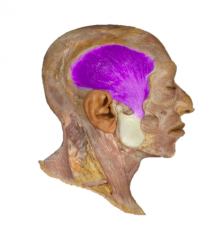
|
Temporalis: Action: Elevation of mandible during mastication (chewing) |
|

|
Masseter: Action: Elevation of the mandible, with smaller roles in protraction, retraction, and lateral and medial excursion (mastication) |
|

|
Orbicularis Oculi: Action: Sphincter of the eyelids; closes eye in blinking, squinting, and sleep; aids in flow of tears across eye |
|

|
Levator Palpabrae Superioris: Action: Elevates upper eyelid; opens eye |
|
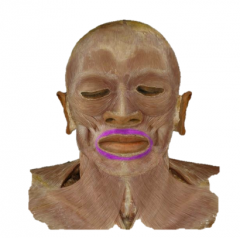
|
Orbicularis Oris: Action: Encircles mouth, closes lips, protrudes lips as in kissing; uniquely developed in humans for speech |
|
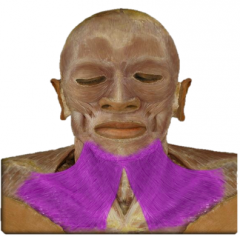
|
Platysma: Action: Draws lower lip and angle of mouth downward in expressions of horror or surprise; may aid in opening mouth widely |
|
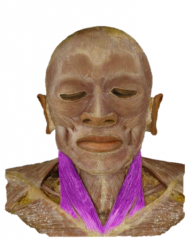
|
Sternocleidomastoid: Origin: Manubrium of sternum; medial one-third of clavicle Insertion: Mastoid process of temporal bone Action: Unilateral action tilts head slightly upward and toward the opposite, as in looking over one's contralateral should. Rotating head left or right. Bilateral action draws head straightforward and down. |
|
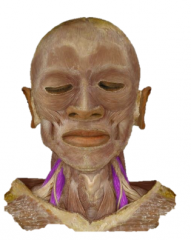
|
Scalenes (Anterior, Middle, and Posterior): Action: Bilateral contration flexes neck. If spine is fixed, scalenes elevate ribs 1-2 and aid in breathing. |
|
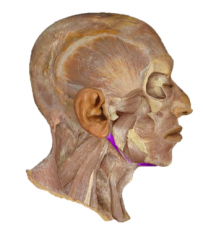
|
Digastric: Action: Depresses mandible when hyoid is fixed; opens mouth widely, as when ingesting food or yawning; elevates hyoid when mandible is fixed |
|

|
Stylohyoid: Origin: Styloid process of temporal bone Insertion: Hyoid bone Action: Elevates and retracts hyoid |
|

|
Mylohyoid: Origin: Inferior margin of mandible Insertion: Hyoid bone Action: Spans mandible from side to side and forms floor of mouth; elevates floor of mouth in initial stage of swallowing |
|

|
Sternohyoid: Origin: Manubrium of sternum; medial end of clavicle Insertion: Hyoid bone Action: Depresses hyoid after it has been elevated |
|
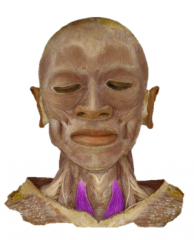
|
Sternothyroid: Action: Depresses larynx after it has been elevated in swallowing and vocalization |
|
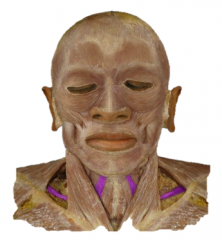
|
Omohyoid: Action: Depresses hyoid after it has been elevated |
|

|
Thyrohyoid: Action: Depresses hyoid |
|

|
External Intercostals: Action: When scalenes fix rib 1, external intercostals elevate and protract ribs 2-12, expanding the thoracic cavity and creating a partial vacuum causing inflow of air |
|
|
Internal Intercostals: Action: In inspiration, the inter cartilaginous part aids in elevating the ribs and expanding the thoracic cavity; in expiration, the interosseous part depresses and retracts the ribs, compressing the thoracic cavity and expelling air |
|
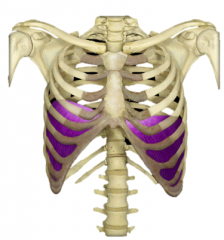
|
Diaphragm: Action: prime mover of inspiration; contraction compresses abdominal viscera and aids in childbirth and expulsion of urine and feces |
|

|
Rectus Abdominis: Action: Flexes trunk, stabilizes pelvic region during walking; and compresses abdominal viscera |
|
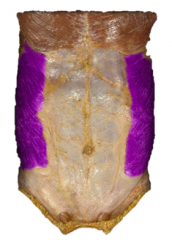
|
External Abdominal Oblique: Action: Support viscera; stabilizes vertebral column; maintains posture |
|
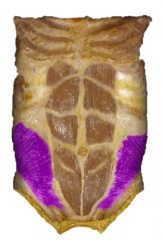
|
Internal Abdominal Oblique: Action: Support viscera; stabilizes vertebral column; maintains posture; unilateral contraction causes ipsilateral rotation of waist |
|
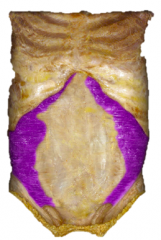
|
Transverse Abdominis: Action: Compresses abdominal contents; does not contribute to vertebral column movements |
|
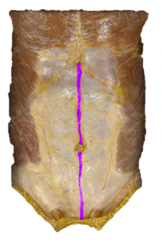
|
Linea Alba: Non-muscular, fibrous structure running between the xiphoid process and pubic symphysis Insertion site for transverse abdominis |
|
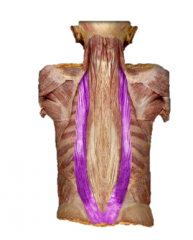
|
Iliocostalis: Action: Lateral flexion of vertebral column; extension of vertebral column; depression of ribs "Antigravity" muscle |
|

|
Longissimus: Action: Unilateral: lateral flexion of vertebral column and rotation of head Action: Bilateral: extension of vertebral column and head Depresses ribs; "Antigravity" muscle |
|
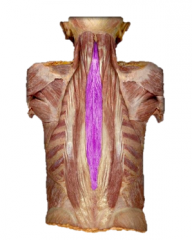
|
Spinalis: Action: Unilateral: Lateral flexion of vertebral column Action: Bilateral: Extension of vertebral column "Antigravity" muscle |

